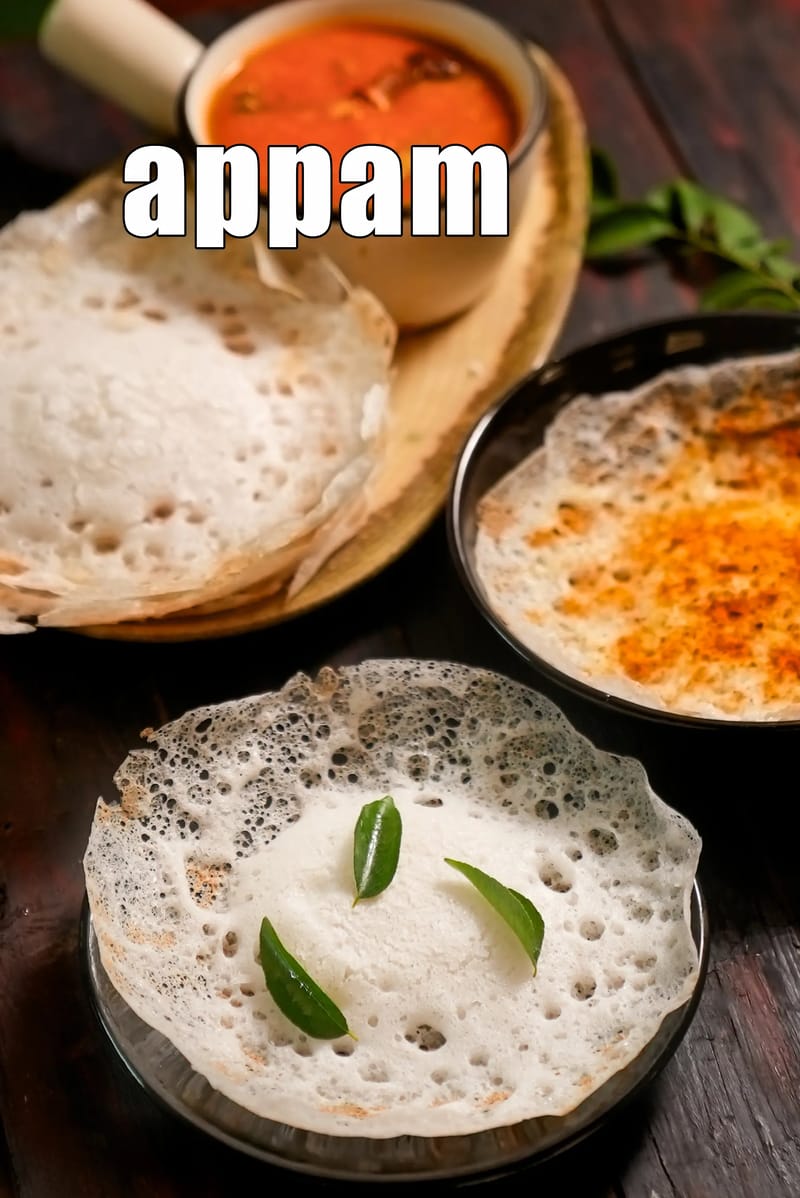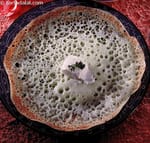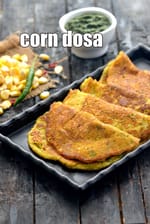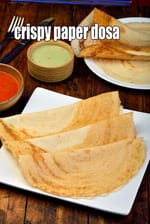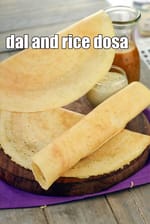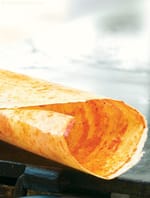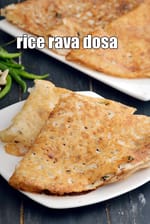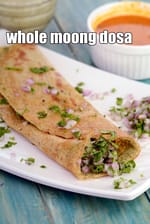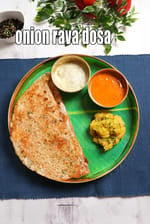Appam recipe | Appam Kerala Recipe | South Indian appam with yeast |
Table of Content
appam recipe | appam Kerala Recipe | South Indian appam with yeast | with 35 amazing images.
appam, a South Indian delicacy, is a thin, bowl-shaped pancake boasting a unique textural contrast. Its crisp, lacy edges give way to a soft and fluffy center, creating a delightful experience with every bite. Made with fermented rice flour and coconut milk, appam boasts a subtle sweet and nutty flavor that compliments savory dishes perfectly. The addition of spices like cardamom can add a touch of warmth, while the naturally gluten-free nature of appam makes it a versatile option for various dietary needs. Whether enjoyed plain or with chutneys, vegetables, or even an egg, appam offers a delicious and satisfying journey for your taste buds.
appam has various names depending on the region in India and Sri Lanka where it is made. Here are some of the most common alternatives:
India:
• Kerala:
• Unniappam (small appam)
• Neyyappam (appam cooked in ghee)
• Kuzhappam (cooked in a kuzhi or cavity)
• Ganapathi appam
• Koottappam (a pile of appams)
• Tamil Nadu :
• Kuzhi paniyaram
• Karnataka :
• Appe
• Kajjaya (in Coorg region)
• Konkani community (Karnataka):
• Mulik (made with semolina, jackfruit or banana)
• Sri Lanka :
• Aappa
These names might have slight variations in pronunciation based on local dialects. Additionally, some regional variations of appam might have specific names depending on the ingredients or cooking methods used.
Main ingredients of appam.
In a mixer put 2 cups of uncooked rice (chawal), soaked for 4 to 5 hours and drained. Rice flour forms the base of appam batter, providing structure and body to the thin pancake. The starch in the rice flour helps the batter hold its shape and allows for the characteristic bowl-like shape of appam to form during cooking.
Add 1 cup coconut milk (nariyal ka doodh). Coconut milk is naturally rich in fats, which contribute to a soft and fluffy texture in the appam batter. This creates a pleasing contrast to the crispy exterior formed during cooking. Appam batter traditionally avoids gluten-containing flours like wheat. Coconut milk provides a binding agent, allowing the batter to hold its shape and rise while remaining gluten-free.
Pro tips for appam. 1. To make yeast mixture in a bowl put 1/2 tsp instant dry yeast. Instant dry yeast is generally more readily available in stores compared to toddy (palm wine), which was traditionally used as a leavening agent in appam. This makes it a convenient option for home cooks. Instant dry yeast has a longer shelf life compared to fresh toddy, which needs to be used within a short period. Instant dry yeast performs well across a wider range of temperatures, which can be helpful in regions with cooler climates where toddy fermentation might be less efficient. 2. Add ½ cup of warm water. Warm water, ideally between 100°F and 110°F (37°C and 43°C), is added to dry yeast in making appam. Appam batter often includes sugar, toddy (palm wine), or other ingredients. Warm water can help dissolve these components more efficiently, leading to a smoother batter and better distribution of flavors.
Serve appam with milagai podi powder, coconut chutney , sambar and coconut stew.
Enjoy appam recipe | appam Kerala Recipe | South Indian appam with yeast | with step by step photos.
Appam, Appam Kerala Recipe recipe - How to make Appam, Appam Kerala Recipe
Tags
Soaking Time
5 hours
Preparation Time
15 Mins
Cooking Time
30 Mins
Baking Time
0 Mins
Baking Temperature
0
Fermenting Time
3 hours
Total Time
45 Mins
Makes
15 appams
Ingredients
For The Appam
- 2 cups uncooked rice (chawal) , soaked for 4 to 5 hours and drained
-
1/2 cup cooked rice (chawal)
- 1/2 tsp instant dry yeast
- 2 pinches of sugar
- 1 cup coconut milk (nariyal ka doodh)
- salt to taste
- 2 tsp sugar
- 6 tsp oil for greasing and cooking
For Serving With Appam
Method
For the appam
- Combine the soaked rice, cooked rice and approx. ½ cup of warm water and blend in a mixer to smooth paste. Keep aside.
- Combine the instant dry yeast, sugar and ½ cup of warm water in a bowl and mix well.
- Cover and keep aside for 10 to 20 minutes or till bubbles appear.
- Combine the ground rice paste, coconut milk, salt and sugar and mix well.
- Add the prepared yeast mixture and mix very well. Cover and keep aside to ferment for 2 to 3 hours.
Making appam
- To make appam, heat an appachatti (appam kadhai) and grease it lightly with oil.
- Pour a big ladleful of the batter into it and slowly rotate the kadhai in a circular motion so that a thin layer forms on the side while it remains thick in the centre.
- Put a little oil on the edges, cover with a lid and cook on a slow flame for 2 to 3 minutes, remove the appam when the centre fluffy part is cooked.
- Repeat with the remaining batter to make 14 more appams.
- Serve appam immediately with coconut stew.
Appam recipe |Â Appam Kerala Recipe | South Indian appam with yeast |Â Â Video by Tarla Dalal
Appam, Appam Kerala Recipe recipe with step by step photos
-
-
like Appam recipe | Appam Kerala Recipe | South Indian appam with yeast | then see our collection of South Indian recipes, collection of appe recipes and some recipes we love.
- instant rava set dosa | instant sponge dosa | no fermentation sponge dosa | instant suji appam |
- palak paneer uttapam | spinach uttapam | suji palak uttapam |
-
like Appam recipe | Appam Kerala Recipe | South Indian appam with yeast | then see our collection of South Indian recipes, collection of appe recipes and some recipes we love.
-
-
what is appam made of ? See below image of list of ingredients to make appam.

-
what is appam made of ? See below image of list of ingredients to make appam.
-
-
Q. My batter did rise and the taste was amazing. The problem is that the batter didn’t stick to the sides of the pan properly. It would just become very thick and as a result the centre was very thick too.
The batter should rise, keep it in a warm place and it always depends on the weather conditions also. The batter will take time to rise if the weather outside is cold. The centre of the appam will always be thick -
Q.When I put the batter in the kadhai, it was not spreading properly.?
Make sure the kadhai is hot when you make the appams. If the kadhai is not hot enough the batter will bounce back to the centre. -
Q. My batter didn't rise instead it lumps down with a layer of water on top. I''ve used pre-boiled rice this time, but I've experimented with different varieties of rice and I don't think it is a problem because I've had this issue with raw rice too. What do you think is the problem?
We have used normal raw rice which is available everywhere, also make sure you keep the batter to ferment in a warm place. Cold weather can make the batter take little more time to ferment. Dry yeast also should be dissolved and mixed well in the batter. -
Q. I followed the recipe to the T. Two problems occured, the batter did not rise at all even after several hours of being left undisturbed. Second, it split at the edges as soon as I poured it into the appamchatty. Please advise on what could have gone wrong. I used idli rice for the uncooked rice which I soaked for 4 hours?
The uncooked rice you have used is probably the wrong one.You need to use raw rice also known as (Kaccha chawal) in hindi which is readily available in any grocery store. And also see that you use thick coconut milk as you are adding warm water while grinding the rice. More water will split when you put in the appamchatty. -
Q. Coconut milk used is thick or thin? How much coconut will i need for 1 cup of coconut milk if i make it at home?
Coconut milk used in the recipe is thick coconut milk and is readymade.
-
Q. My batter did rise and the taste was amazing. The problem is that the batter didn’t stick to the sides of the pan properly. It would just become very thick and as a result the centre was very thick too.
-
-
in a mixer put 2 cups uncooked rice (chawal) , soaked for 4 to 5 hours and drained. Rice flour forms the base of appam batter, providing structure and body to the thin pancake. The starch in the rice flour helps the batter hold its shape and allows for the characteristic bowl-like shape of appam to form during cooking.

-
Add 1/2 cup cooked rice (chawal).
-2-202946.webp?w=800&format=webp)
-
Add approx. ½ cup of warm water.

-
Blend in a mixer to smooth (very fine ) paste.

-
Keep aside rice paste.

-
in a mixer put 2 cups uncooked rice (chawal) , soaked for 4 to 5 hours and drained. Rice flour forms the base of appam batter, providing structure and body to the thin pancake. The starch in the rice flour helps the batter hold its shape and allows for the characteristic bowl-like shape of appam to form during cooking.
-
-
To make yeast mixture in a bowl put 1/2 tsp instant dry yeast. Instant dry yeast is generally more readily available in stores compared to toddy (palm wine), which was traditionally used as a leavening agent in appam. This makes it a convenient option for home cooks.Instant dry yeast has a longer shelf life compared to fresh toddy, which needs to be used within a short period. Instant dry yeast performs well across a wider range of temperatures, which can be helpful in regions with cooler climates where toddy fermentation might be less efficient.

-
Add 2 pinches of sugar (optional). Sugar is believed to provide readily available simple sugars for the yeast to initiate the fermentation process, especially in cooler environments.

-
Add ½ cup of warm water. Warm water, ideally between 100°F and 110°F (37°C and 43°C), is added to dry yeast in making appam. Appam batter often includes sugar, toddy (palm wine), or other ingredients. Warm water can help dissolve these components more efficiently, leading to a smoother batter and better distribution of flavors.

-
Mix well.

-
Cover and keep aside for 10 to 20 minutes or until bubbles appear. In colder climates it may take longer.

-
After 10 to 20 minutes there should be a froth on top. If there is not then discard this yeast mixture and make a fresh batch.

-
To make yeast mixture in a bowl put 1/2 tsp instant dry yeast. Instant dry yeast is generally more readily available in stores compared to toddy (palm wine), which was traditionally used as a leavening agent in appam. This makes it a convenient option for home cooks.Instant dry yeast has a longer shelf life compared to fresh toddy, which needs to be used within a short period. Instant dry yeast performs well across a wider range of temperatures, which can be helpful in regions with cooler climates where toddy fermentation might be less efficient.
-
-
To make appam batter, in a bowl put the prepared rice paste.

-
Add 1 cup coconut milk (nariyal ka doodh). Coconut milk is naturally rich in fats, which contribute to a soft and fluffy texture in the appam batter. This creates a pleasing contrast to the crispy exterior formed during cooking. Appam batter traditionally avoids gluten-containing flours like wheat. Coconut milk provides a binding agent, allowing the batter to hold its shape and rise while remaining gluten-free.

-
Add salt to taste. We added 1 tsp salt.

-
Add 2 tsp sugar. A small amount of sugar (usually less than 1 tablespoon) can aid the fermentation process by feeding the yeast, which helps the batter rise and become lighter. A subtle sweetness can complement the savory notes of coconut and spices in the appam. However, appam is not typically considered a sweet dish, and the sweetness from sugar should be very mild.

-
Mix well. The batter may be slightly thick at this stage and that is okay.

-
Add the prepared yeast mixture.

-
Mix very well. If the batter is too thick then add little warm water.

-
Cover and keep aside the batter to ferment for 2 to 3 hours. This is essential for achieving the characteristic spongy and soft texture of appam. Appam batter ferments well in warm climates or when placed near a heat source like a stovetop or oven. In cold climate batter will take longer to ferment.

-
Fermented appam batter.

-
To make appam batter, in a bowl put the prepared rice paste.
-
-
To make Appam recipe | Appam Kerala Recipe | South Indian appam with yeast | heat an appachatti (appam kadhai) and grease it lightly with oil.
-1-202949.webp?w=800&format=webp)
-
Pour a big ladleful of the batter into it.

-
Slowly rotate the kadhai in a circular motion so that a thin layer forms on the side while it remains thick in the centre.

-
Put a little oil on the edges.

-
Cover with a lid and cook on a slow flame for 2 to 3 minutes.

-
Remove the appam when the centre fluffy part is cooked.

-
Serve Appam | Appam Kerala | South Indian appam with yeast | immediately with milagai podi powder, coconut chutney, sambar and coconut stew.

-
To make Appam recipe | Appam Kerala Recipe | South Indian appam with yeast | heat an appachatti (appam kadhai) and grease it lightly with oil.
-
-
In a bowl put 2 cups uncooked rice (chawal).
-1-202950.webp?w=800&format=webp)
-
Add enough water to soak the rice.

-
Clean the rice as you can see the water looks cloudy.

-
Wash the rice repeatedly, changing the water until it runs clear and free of starch.

-
Cover with a lid and soak for 4 to 6 hours or overnight. Soaking ensures the rice kernels absorb water more evenly,leading to more consistent and even cooking, with fewer mushy or uncooked grains.

-
Image of rice after soaking.

-
Drain.

-
Soaked and drained rice.

-
In a bowl put 2 cups uncooked rice (chawal).
-
-
To make yeast mixture in a bowl put 1/2 tsp instant dry yeast. Instant dry yeast is generally more readily available in stores compared to toddy (palm wine), which was traditionally used as a leavening agent in appam. This makes it a convenient option for home cooks.Instant dry yeast has a longer shelf life compared to fresh toddy, which needs to be used within a short period. Instant dry yeast performs well across a wider range of temperatures, which can be helpful in regions with cooler climates where toddy fermentation might be less efficient.

-
Add ½ cup of warm water. Warm water, ideally between 100°F and 110°F (37°C and 43°C), is added to dry yeast in making appam. Appam batter often includes sugar, toddy (palm wine), or other ingredients. Warm water can help dissolve these components more efficiently, leading to a smoother batter and better distribution of flavors.

-
Add 1 cup coconut milk (nariyal ka doodh). Coconut milk is naturally rich in fats, which contribute to a soft and fluffy texture in the appam batter. This creates a pleasing contrast to the crispy exterior formed during cooking. ppam batter traditionally avoids gluten-containing flours like wheat. Coconut milk provides a binding agent, allowing the batter to hold its shape and rise while remaining gluten-free.

-
Add 2 tsp sugar. A small amount of sugar (usually less than 1 tablespoon) can aid the fermentation process by feeding the yeast, which helps the batter rise and become lighter. A subtle sweetness can complement the savory notes of coconut and spices in the appam. However, appam is not typically considered a sweet dish, and the sweetness from sugar should be very mild.

-
Cover and keep aside the batter to ferment for 2 to 3 hours. This is essential for achieving the characteristic spongy and soft texture of appam. Appam batter ferments well in warm climates or when placed near a heat source like a stovetop or oven light. In cold climate batter will take longer to ferment.

-
To make yeast mixture in a bowl put 1/2 tsp instant dry yeast. Instant dry yeast is generally more readily available in stores compared to toddy (palm wine), which was traditionally used as a leavening agent in appam. This makes it a convenient option for home cooks.Instant dry yeast has a longer shelf life compared to fresh toddy, which needs to be used within a short period. Instant dry yeast performs well across a wider range of temperatures, which can be helpful in regions with cooler climates where toddy fermentation might be less efficient.
-
-
If you don't have appachatti (appam kadhai) then cook the appam on a tava.
-1-202952.webp?w=800&format=webp)
-
Tava appam. Serve tava appam with coconut chutney, sambar or coconut stew.

-
If you don't have appachatti (appam kadhai) then cook the appam on a tava.
-
-
To make gun powder appam, podi appam recipe, sprinkle milagai podi powder and little ghee in the centre and enjoy its taste.

-
To make gun powder appam, podi appam recipe, sprinkle milagai podi powder and little ghee in the centre and enjoy its taste.
Nutrient values (Abbrv)per plate
Nutrient values (Abbrv) per appam
| Energy | 138 cal |
| Protein | 1.9 g |
| Carbohydrates | 19.5 g |
| Fiber | 1.3 g |
| Fat | 6.1 g |
| Cholesterol | 0 mg |
| Sodium | 4 mg |
Click here to view Calories for Appam, Appam Kerala Recipe
The Nutrient info is complete
bhavinihemangshah
March 5, 2021, 3:22 p.m.
This recipe is awesome...the mesurements are perfect and easy to make......my family said it' tastes same as their south Indian friend made it......must try this with veg stew.....
Tarla Dalal
March 5, 2021, 3:22 p.m.
Thanks Bhavini, please keep trying more recipes and providing your feedback.
Leena_Dhoot
Feb. 7, 2021, 6:08 p.m.
I never thought I will be able to pull off a dish as difficult as appam, but this recipe is like a helping guide at all steps! Thanks for this! I loved it.
Naresh
Nov. 28, 2020, 3:50 p.m.
Tarla Dalal
Nov. 28, 2020, 3:50 p.m.
Thanks for the feedback !!! Keep reviewing recipes and articles you loved.
Bandini
Aug. 21, 2020, 11:15 a.m.
My batter did rise and the taste was amazing. The only problem is that the batter didn?t stick to the sides of the pan properly... it would just become very thick and as a result the centre was very thick too .. please help.
Tarla Dalal
Aug. 21, 2020, 11:15 a.m.
Hi, the batter should rise , keep itin a warm place and it always depends on the weather conditions also, the centre of the appam will always be thick...
hitaishi praful shah
Sept. 26, 2018, 12:06 p.m.
Tarla Dalal
Sept. 26, 2018, 12:06 p.m.
Thanks for the feedback.
Maria.K
Aug. 24, 2016, 2:06 p.m.
coconut milk- thick or thin? how much coconut for 1 cup of coconut milk?
Tarla Dalal
Aug. 24, 2016, 2:06 p.m.
Hi Maria, Coconut milk used in the recipe is thick coconut milk and is readymade.
AVNI
May 11, 2016, 3:17 p.m.
What if I added 1tsp of yeast in the same recipe instead of 1/2 tsp?? How can I improve my batter now??
Tarla Dalal
May 11, 2016, 3:17 p.m.
Hi, no do add more quantity of yeast, as it might make the batter sour and spoil the taste.
Ambika Sharma
Dec. 31, 2014, 1:13 p.m.
All the recipes in this articles is Healthy & Good. Made Pineapple-Celery-Cottage Cheese Sandwich at home yesterday for my kids after they are back from school. Both liked the taste of sandwich. It was really tasty. Will surely try Pineapple Cucumber and Celery Salad, celery soup, Apple Almond and Celery Salad with Honey Mustard Dressing, Celery Garlic Toast.
Amod Deo
Aug. 19, 2014, 11:14 p.m.
Some excellent recipes here. I would like to be a part of this platform , my expertise is in lost recipes from all parts of India , from the Royal kitchens and from small village typical farm recipes.
Tarla Dalal
Aug. 19, 2014, 11:14 p.m.
Hi Amod , we are delighted you loved the Appam recipe. Please keep posting your thoughts and feedback and review recipes you have loved. Happy Cooking.
Ranjan Desai
May 29, 2014, 9:30 a.m.
sangita biswal
April 30, 2012, 11:40 a.m.
it is very very tasty.thank you so much for this recipe
Tarla Dalal
April 30, 2012, 11:40 a.m.
Hi Sangita , we are delighted you loved the Appam recipe. Please keep posting your thoughts and feedback and review recipes you have loved. Happy Cooking.
Foodie #669323
Feb. 27, 2012, 7:57 p.m.
Rajitharan
July 2, 2011, 10:23 a.m.
Hi! Just like Nomuk said, my batter didn''t rise instead it lumps down with a layer of water on top. I''ve used pre-boiled rice this time, but I''ve experimented with different varieties of rice and I don''t think it is a problem because I''ve had this issue with raw rice too. What do you think is the problem?
Tarla Dalal
July 2, 2011, 10:23 a.m.
Hi Rajitharan, We have used normal raw rice which is available every where, also make sure you keep the batter to ferment in a warm place. Cold weather can make the batter take little more time to ferment Dry yeast also should be dissolved and mixed well in the batter. Kindly see the video below it will help you https://www.youtube.com/edit?video_id=DMEK52R9c70
Padmini
April 7, 2011, 4:03 p.m.
nc
Dec. 8, 2010, 12:44 a.m.
I would like to know ow to grow bean sprouts this long. Please advice. Thx
Tarla Dalal
Dec. 8, 2010, 12:44 a.m.
Hi, Bean sprouts have to be kept for a long time that''s when you get them, long.
Nomuk
Oct. 29, 2010, 4:13 p.m.
I followed the recipe to the T. Two problems. First, the batter did not rise at all even after several hours of being left undisturbed. Second, it split at the edges as soon as I poured it into the appamchatty. Please advise on what could have gone wrong. P.S I used idli rice for the uncooked rice which I soaked for 4 hours.
Tarla Dalal
Oct. 29, 2010, 4:13 p.m.
Hi Nomuk, the uncooked rice you have used is probably the wrong one.. You need to use raw rice also known as (Kaccha chawal) in hindi which is readily available in any grocery store.. And also see that you use thick coconut milk as you are adding warm water while grinding the rice.. More water will spilt when you you put in the appamchatty. Do try the recipe again and give us your feedback.. you can also watch the video on appam. Here is the link https://www.youtube.com/watch?v=DMEK52R9c70
